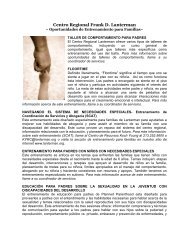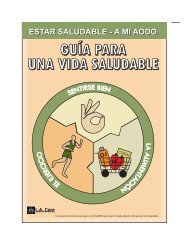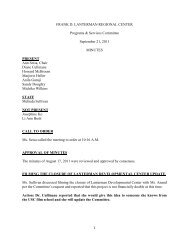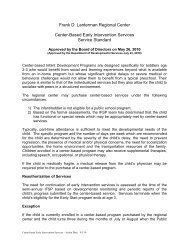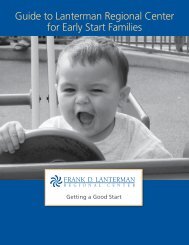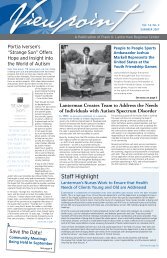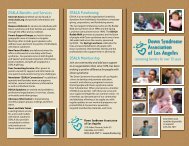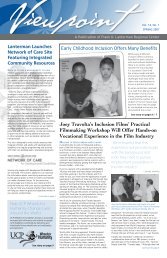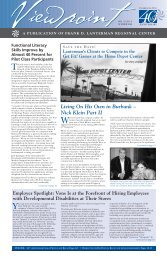Health& Wellness - Frank D. Lanterman Regional Center
Health& Wellness - Frank D. Lanterman Regional Center
Health& Wellness - Frank D. Lanterman Regional Center
Create successful ePaper yourself
Turn your PDF publications into a flip-book with our unique Google optimized e-Paper software.
2<br />
The New Medicare<br />
Prescription Drug Benefit:<br />
Its Effect on <strong>Regional</strong><br />
<strong>Center</strong> Clients<br />
4<br />
You may have heard<br />
or read that the<br />
federal government<br />
has passed a law<br />
expanding the Medicare<br />
program to include a<br />
prescription drug benefit, called Medicare Part D.<br />
The new benefit will take effect on January 1, 2006<br />
and it will affect <strong>Regional</strong> <strong>Center</strong> clients who<br />
receive health coverage under both the Medicare<br />
and Medi-Cal programs. These clients are called<br />
“dual-eligible.” The main change is that their<br />
prescription medications will be paid for by<br />
Medicare rather than Medi-Cal.<br />
There are several things that our dual-eligible<br />
clients, their families and service providers should<br />
know about the changes that are coming.<br />
LOW-INCOME SUBSIDY<br />
For people who are covered by Medicare only,<br />
there will be fairly substantial co-payments and<br />
other costs associated with this new drug benefit.<br />
People who are dual-eligible, however, will receive a<br />
low-income subsidy that will pay a large portion of<br />
these costs. In other words, <strong>Regional</strong> <strong>Center</strong> clients<br />
receiving Medi-Cal and Medicare will receive this<br />
low-income subsidy to help them pay the costs that<br />
Medicare-only beneficiaries must pay for<br />
prescription drugs. These clients will still be<br />
required to make co-payments, but the amounts of<br />
these co-payments will be small. For example, copayments<br />
for our clients will most likely be $1 or $3<br />
for a prescription. In addition, this new benefit may<br />
not cover all of the medicines that a person is<br />
taking. (See below for more information)<br />
LETTER OF NOTIFICATION<br />
Anyone on Medicare can apply to receive the lowincome<br />
subsidy, but people who are dual-eligible<br />
don’t have to apply. The government has already<br />
decided that these people will receive the subsidy.<br />
So, during the month of June, <strong>Regional</strong> <strong>Center</strong><br />
clients who are dual-eligible should have received<br />
letters from Medicare telling them that they will be<br />
getting the low-income subsidy. Clients and families<br />
should be sure to watch the mail for a letter from<br />
Medicare. If you receive such a letter of notification you<br />
do not have to reply to it. <strong>Regional</strong> <strong>Center</strong> clients<br />
should, however, notify their service coordinators<br />
that they received this letter.<br />
PICKING A PRESCRIPTION DRUG PLAN<br />
The Medicare prescription drug benefit will be<br />
provided through a series of “plans,” and each<br />
beneficiary must choose which plan they want to be<br />
covered by. These plans will differ from one<br />
another in the drugs that they cover. So, while one<br />
plan may cover all of the drugs a person takes,<br />
another plan might not. For this reason it is very<br />
important that a person try to find a plan that covers all<br />
of the drugs that they take. Clients and families should<br />
be assured, however, that the <strong>Regional</strong> <strong>Center</strong> will<br />
help ensure that clients have access to all of the<br />
medications they need.<br />
In the fall of 2005, all eligible beneficiaries will<br />
receive a letter inviting them to choose the<br />
prescription drug plan that they want to join. If<br />
a person does not choose a plan by December<br />
31, 2005, the government will select one for<br />
them so that they can begin receiving the<br />
benefit on January 1, 2006. Clients and their<br />
families should be sure to make a choice so<br />
they will be enrolled in the plan that best meets<br />
their needs.<br />
At the moment we have no information about what<br />
prescription drug plans will be available to <strong>Regional</strong><br />
<strong>Center</strong> dual-eligible clients or what will be covered<br />
by these plans. As we move closer to the fall,<br />
however, we will be receiving more information. We<br />
will then be able to help clients and their families<br />
evaluate the various plans to decide which one is<br />
the best choice for them.<br />
Parents of Children with Special<br />
Needs can Benefit from the New<br />
Paid Family Leave Law<br />
Article courtesy of the Paid Family Leave Collaborative (www.paidfamilyleave.org)<br />
Do you need to take time off work to care for your child with special needs? Are you worried<br />
about whether you can afford to take time off, or whether you will get your job back?<br />
California has a new law to benefit working parents who need to take time off to care for a child<br />
with a serious health condition. If you have a child with special needs, his or her condition may be<br />
considered a serious health condition, and you may be eligible for Paid Family Leave benefits.<br />
What are Paid Family Leave Benefits?<br />
Paid Family Leave benefits are partial wages paid by the Employment Development Department<br />
(EDD). Like short-term disability or pregnancy disability, the payments are approximately 55<br />
percent of the employee’s wages. Employees can receive the benefits for up to six weeks each<br />
year, either intermittently or all at once, if they have to miss work to care for a child, spouse,<br />
registered domestic partner or parent with a serious health condition.<br />
Who is eligible to receive Paid Family Leave?<br />
Everyone who works and participates in the State Disability Insurance (SDI) program is eligible,<br />
whether they work full-time or part-time, and regardless of the size of the employer or how long<br />
they have worked there. Most California employees pay into SDI. (State, school district and some<br />
local government employees do not.) Check your paystub for an SDI deduction. To receive<br />
benefits, you must be taking time off work to bond with a new child (birth, adopted or foster) or<br />
to care for a parent, spouse, partner or child with a serious health condition.<br />
Does your child have a “serious health condition?”<br />
Under the new law, several common physical and mental impairments are considered serious<br />
health conditions. Some examples are asthma, epilepsy, cerebral palsy and spina bifida.<br />
Generally, a serious health condition is one which:<br />
• requires a hospital stay; or<br />
• prevents an individual from participating in normal activities for three days or more, for<br />
example, a child’s inability to attend school; or<br />
• requires multiple treatments to prevent incapacitating the individual; or<br />
• is a chronic serious health condition; or<br />
• is an incurable illness.<br />
Paid Leave Information<br />
Employment Development Department:<br />
877.BE.THERE (English)<br />
800.563.2441 (TTY)<br />
866.658.8846 (Spanish)<br />
www.edd.ca.gov<br />
Legal Hotlines<br />
The Legal Aid Society –<br />
Employment Law <strong>Center</strong>: 800.880.8047<br />
Asian Law Caucus: 415.896.1701<br />
Equal Rights Advocates: 800.839.4372<br />
California Women’s Law <strong>Center</strong>: 213.637.9900<br />
To find out if your child’s condition meets the<br />
legal requirements, ask your health care<br />
practitioner or call the Paid Family Leave<br />
Collaborative numbers listed to the left.<br />
What if you need to take your child to<br />
appointments one day each week?<br />
Paid Family Leave benefits are available whether<br />
you take days off consecutively or intermittently. If<br />
you regularly miss work to take your child to<br />
appointments for therapy or treatments, you may<br />
receive benefits to compensate you for missed<br />
work time.<br />
Must the employer allow an employee to take<br />
leave?<br />
All employees covered by the Family and Medical<br />
Leave Act (FMLA) have the right to take leave and return to their job. You are covered by FMLA<br />
if you have worked for your employer for one year and 1,250 hours in that year, and your<br />
employer has 50 or more employees within a 75-mile radius.<br />
Even if you are not covered by FMLA, you may still receive Paid Family Leave benefits if you have<br />
been paying into the system. Talk to your employer about getting permission to take time off<br />
work. Parents with legal questions about their employment and Paid Family Leave should call<br />
the hotlines listed above.<br />
How to Apply for Paid Leave Benefits<br />
File a claim form with the Employment Development Department. Claim forms are available<br />
from your medical practitioner or from EDD. You will be asked to provide a medical certificate<br />
signed by a health practitioner stating that you are needed to care for the child. There is a sevenday<br />
waiting period before benefits are paid.<br />
This article is intended to provide accurate, general information about Paid Family Leave. Because laws<br />
and legal procedures are subject to frequent change and differing interpretations, the Paid Family Leave<br />
Collaborative cannot ensure that the information in this article is current, nor be responsible for any use to<br />
which it is put. Do not rely on this information without consulting an attorney or the appropriate agency<br />
about your rights.<br />
Online Resources for Airline Travel for Medical Needs:<br />
Association of Cancer Online Resources (ACOR)<br />
www.acor.org/ped-onc/resources/airlineflights.html<br />
The organizations listed on this site provide airline flights for patients that need to<br />
travel for medical reasons. Listings include a description of the type of air service<br />
offered and contact information. Some of the organizations included in this listing<br />
are Air Care Alliance, Air LifeLine, Angel Flight, Children’s<br />
Flight of Hope, Corporate Angel Network, Delta Air<br />
Sky Wish at United Way, Dreamline,<br />
LifeLine Pilots, Mercy Medical Airlift,<br />
Miracle Flights for Kids, National Patient Air<br />
Travel HELPLINE, Northwest Airlines Kid<br />
Cares program, Operation Liftoff, American<br />
Airlines Advantage Miles for Kids in Need,<br />
and Wings of Freedom.



